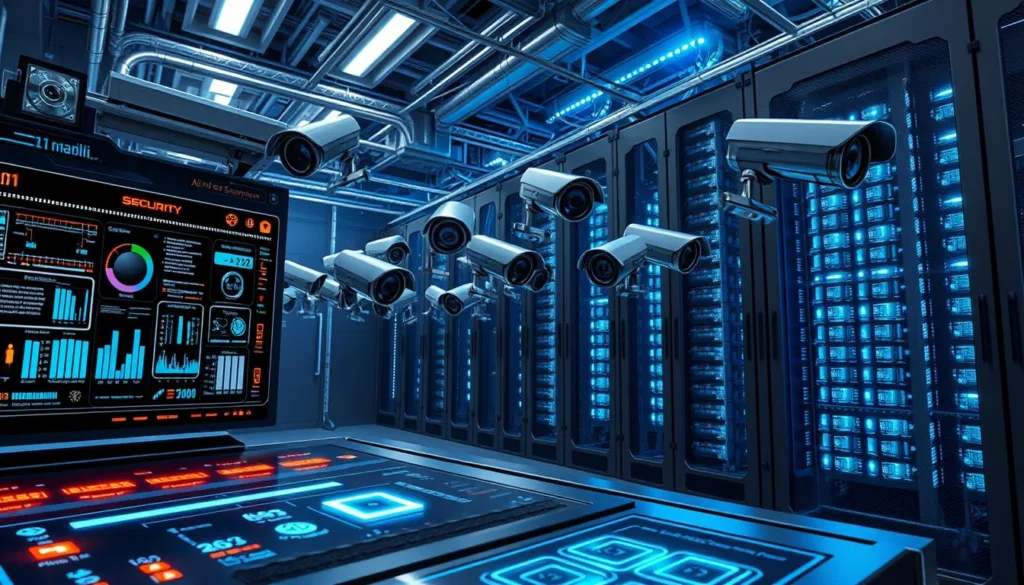LangGraph for cybersecurity is a top-notch AI-powered security tool. It boosts digital defense with smart threat detection and response. It’s key for a strong cybersecurity plan. With LangGraph, companies can better guard against cyber threats, keeping their data and systems safe.

LangGraph lets companies use AI to outsmart new threats. It uses advanced analytics and machine learning to spot and handle security breaches fast. This keeps companies ahead of cyber threats, lowering the chance of data breaches and other security issues.
Introduction to LangGraph
LangGraph is built to give companies a solid cybersecurity setup. It uses AI to improve threat detection and response. By using LangGraph, companies can protect their systems and data from cyber threats. This keeps their cybersecurity strong.
Key Takeaways
- LangGraph is an AI-powered security solution that enhances digital defense through advanced threat detection and response capabilities.
- Integrating LangGraph can significantly improve an organization’s ability to protect against cyber threats.
- LangGraph utilizes advanced analytics and machine learning capabilities to identify and respond to potential security breaches in real-time.
- LangGraph provides a robust cybersecurity framework for organizations to maintain a proactive approach to cybersecurity.
- LangGraph helps organizations reduce the risk of data breaches and other security incidents.
Understanding LangGraph for Cybersecurity
LangGraph is a leading technology in cybersecurity. It uses AI to create a strong security framework. This framework helps protect against many cyber threats.
LangGraph analyzes and understands cyber attacks. It can detect and respond to threats quickly. This makes it a powerful tool in the fight against cyber attacks.
The use of AI in cybersecurity has changed the game. AI tools like LangGraph can look at huge amounts of data. They find patterns and predict threats.
This lets organizations stay ahead of cyber attackers. The LangGraph security framework is all about being proactive. It helps prevent breaches and keeps data safe.
Key Components of LangGraph
- Advanced threat detection capabilities
- Real-time monitoring and analysis
- Automated response mechanisms
Knowing how LangGraph works helps organizations see its value. AI is now a must-have in cybersecurity. LangGraph leads the way with its advanced features and strong security framework.
The Evolution of AI-Powered Security Solutions
The world of cybersecurity has changed a lot in recent years. This change is thanks to the rise of AI-powered security solutions. As technology gets better, we need stronger ways to keep our data safe. AI-powered security is now a key part of keeping us safe online.
Big names like Google and Microsoft are putting a lot of money into AI security. They see how important it is for keeping our digital world safe. This investment is helping AI security grow fast.
AI is making security systems smarter. These systems can learn from past threats and get better at stopping new ones. AI helps in many ways, like predicting threats and responding quickly to attacks. It’s making a big difference in many fields.
Some key features of AI-powered security solutions include:
- Advanced threat detection capabilities
- Real-time monitoring and analysis
- Automated response mechanisms
The future of cybersecurity looks bright thanks to AI. It’s driving new ideas and growth in the field. As threats keep coming, we need to keep up with the latest AI security tools to stay safe.
Key Features of LangGraph’s Security Architecture
LangGraph’s security architecture is built to offer top-notch cybersecurity. It uses advanced threat detection to spot potential security risks right away. This is thanks to real-time monitoring that keeps an eye out for anything unusual.
Some of the main features of LangGraph’s security architecture include:
- Advanced threat detection capabilities
- Real-time monitoring systems
- Automated response mechanisms
These elements combine to create a strong security system. It can quickly find and handle security threats.
The automated response helps organizations deal with security issues fast. This reduces the chance of data breaches and other threats. Using LangGraph’s security architecture helps keep sensitive data safe.
Implementation Strategies for LangGraph Security
Organizations need to think carefully about how to add LangGraph security. They must plan well for implementation strategies and security integration. This means setting up LangGraph in their current security systems.
First, they should check their current security setup. They need to see where LangGraph can help. This includes looking at their network, threats, and current security measures. This helps them figure out the best way to add LangGraph.
Important things to think about when adding LangGraph include:
- Doing a detailed risk check to find weak spots
- Creating a detailed plan for adding LangGraph to avoid problems
- Setting up LangGraph to work with their current security tools
- Training security teams on how to use LangGraph well
By taking these steps, organizations can make LangGraph work well. This helps them keep up with new threats and protect important data.
Best Practices for LangGraph Integration
When you add LangGraph to your security setup, think about a few important things. A good security configuration helps avoid risks and attacks. You need to adjust LangGraph to fit your company’s needs.
To get the best out of LangGraph, work on performance optimization. This means tweaking settings, using the right resources, and improving data handling. These steps will make your LangGraph setup more efficient.
As your company gets bigger, think about scaling. You’ll need to make sure LangGraph can handle more work. This might mean growing your system, using load balancing, or moving to the cloud for more flexibility.
- Regularly updating and patching your system to prevent known vulnerabilities
- Implementing robust monitoring and logging mechanisms to detect potential security incidents
- Providing ongoing training and support for personnel to ensure they can effectively utilize the LangGraph system
By following these tips and focusing on security configuration, performance optimization, and scaling, you can make your LangGraph integration work well. It will meet your company’s specific needs and boost its security.
Real-World Applications and Use Cases
LangGraph has many uses in the real world, showing how it can improve cybersecurity. It’s great for places where finding threats is key, like banks and government offices. It offers real-time watching and quick action, perfect for those wanting to up their security game.
LangGraph shines in cloud security, fighting off cyber attacks and keeping data safe. It’s also a big help in handling security issues fast and well. Its uses are wide, from keeping an eye on security events to making sure rules are followed, proving it’s a versatile tool.
The following are some key areas where LangGraph’s real-world applications and use cases are evident:
- Cloud security: protecting against cyber threats and data breaches
- Incident response: swift and effective mitigation of security incidents
- Security information and event management (SIEM): providing real-time monitoring and threat detection
- Compliance management: ensuring adherence to regulatory requirements

LangGraph’s uses show it’s a big help in keeping things safe from cyber threats. It watches things in real time, acts fast, and finds threats, making it a must-have for any serious security effort.
Overcoming Common Security Challenges with LangGraph
LangGraph is a strong tool for boosting cybersecurity. Yet, it faces common issues. One big worry is false positives, which can waste time and lower efficiency. By adjusting LangGraph’s settings and keeping its threat intelligence up to date, companies can cut down on false positives. This way, their security teams can focus on actual threats.
Another big challenge is alert fatigue. This happens when too many alerts flood security teams, making it hard to spot and act on real threats. LangGraph’s advanced analytics and machine learning can help by sorting alerts and giving clear insights. This lets security teams act fast and right when they see a possible breach.
Meeting compliance standards is key for companies. LangGraph makes it easier by watching in real-time and automating reports. This helps show that a company follows the rules. Using LangGraph, companies can lower the chance of breaking rules and avoid big fines.
- Regularly review and update LangGraph’s settings to minimize false positives
- Utilize LangGraph’s analytics and machine learning capabilities to prioritize alerts and alleviate alert fatigue
- Leverage LangGraph’s real-time monitoring and automated reporting to ensure compliance with regulatory requirements
By tackling these common security issues, companies can get the most out of LangGraph. It’s a vital tool for any business looking to stay safe in a changing threat world.
Future of LangGraph in Cybersecurity Landscape
The world of cybersecurity is changing fast, and LangGraph is ready to lead the way. New threats pop up as technology grows, and companies must keep up to stay safe. LangGraph’s fresh approach to security makes it a key player in this evolution.
LangGraph is set to make a big difference in several areas:
- Enhanced threat detection capabilities
- Improved real-time monitoring systems
- Advanced automated response mechanisms
These improvements will help companies fight off new threats better. This means a safer future for cybersecurity.
As the future of cybersecurity keeps changing, LangGraph will be leading the charge. It will give companies the tools they need to face new dangers. LangGraph’s focus on innovation and safety makes it a vital partner for any business in the complex world of cybersecurity.

Conclusion: Embracing LangGraph for Enhanced Security
As we wrap up our look at LangGraph, the future of cybersecurity is clear. LangGraph uses AI to help organizations boost their security. It fights off new digital threats with its advanced threat detection and quick response.
Using LangGraph makes security teams more effective. It helps them keep up with cybercriminals and protect important data. This way, security teams can focus on big-picture tasks, not just day-to-day work.
LangGraph brings a new level of security to the table. It combines smart technology with proactive measures. This means better protection for sensitive information and a safer digital world.
The world of cybersecurity is always changing. That’s why solutions like LangGraph are so important. By using LangGraph, businesses and governments can strengthen their defenses. They can also meet industry standards and keep their digital assets safe from threats.
FAQ
What is LangGraph?
LangGraph is a cutting-edge AI platform for cybersecurity. It uses advanced language processing and graph analytics to boost digital defense. It offers a full security framework to spot, tackle, and lessen cyber threats.
How does LangGraph leverage AI to improve cybersecurity?
LangGraph’s AI helps it scan huge data sets, spot patterns, and find threats fast. This AI power boosts threat detection and response, making security better.
What are the core components of the LangGraph security framework?
LangGraph’s framework has three main parts: threat detection, real-time monitoring, and automated response. Together, they give strong cybersecurity protection.
How does LangGraph’s threat detection capabilities work?
LangGraph uses advanced algorithms to watch network activity and user behavior. It spots threats quickly, letting teams act fast to protect against attacks.
What are the benefits of LangGraph’s real-time monitoring systems?
LangGraph’s monitoring keeps security posture up to date. It analyzes data to catch and alert on suspicious activity. This helps teams respond quickly to threats.
How do LangGraph’s automated response mechanisms work?
LangGraph’s automated responses act fast to block threats. It can isolate devices, block bad traffic, or start incident response. This lessens the damage from cyber attacks.
What are some best practices for integrating LangGraph into an organization’s security infrastructure?
To integrate LangGraph well, follow setup guidelines and fine-tune performance. Also, plan for growth as security needs change. These steps ensure a smooth and effective LangGraph setup.
How can LangGraph help organizations overcome common security challenges?
LangGraph tackles issues like false alarms, alert overload, and compliance. Its advanced analytics and automation cut down on false alarms and streamline operations. This boosts security and meets standards.

